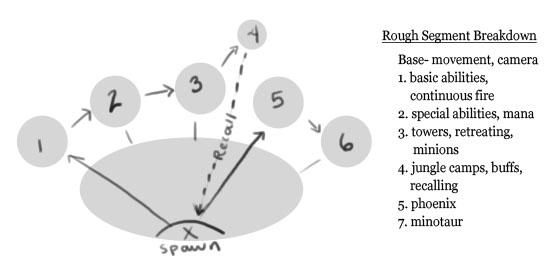**Update**
Smite goes through many iterative changes and revisions.One of these changes was to redo the tutorial to again be more specific to our Conquest gametype, to better introduce new players to the MOBA genre.
I will be updating my blog here soon to detail the new tutorial, and review some of the changes that were made. That being said, you can still read through how the old tutorial functioned below!
———————————————————————————————————————-
Responsibilities:
–Tutorial design, block out, Kismet, matinees, bug fixes, and set dressing.
Process:
Developing the tutorial for HiRez’s title Smite was an interesting challenge. Initially, the tutorial took the shape of trying to teach new players how to be successful in our Conquest game type- which plays similar to games like League of Legends, Dawn of the Ancients, and Heroes of Newearth.
However, as we branched out into creating other game types for players, it was decided that the tutorial should instead focus on the basic of the game: movement, attacking, defenses, item shops, jungle buffs, and more.
I went back to drawing on my whiteboard, outlining what would be good basic skills to teach that would carry across most of the game types. I also needed to consider time; we didn’t want the tutorial to take forever for new players, but there is a lot to teach to someone new to the genre. However, I noticed with my first tutorial design- a condensed lane map mirroring the MOBA style game play- that playtesters felt like it took too long to travel places. With this in mind, I began experimenting with the more “pawprint” layout that’s in game now.

With a pawprint shape, I could break the tutorial down into manageable segments. Each segment would focus on a set of abilities the player would learn, and pit them against enemies of increasing difficulty. It also gave the player an option to retreat back to their base; alternatively, if the player was killed, there would be no long travel time to return to the active segment.
After I finished with a rough block out of the play space, I began using Kismet to work on scripting events. This included triggering when enemies spawned, freezing the player until a skill had been upgraded, matinees for in-game movies, and running health and mana checks to see if the player needed to return to base. During this phase, I worked with one of our programmers to figure out what new Kismet nodes would be needed, and how they would function.
Several people playtested this rough tutorial, and adjustments were made to help tweak timing and flow, clarify objectives, and better guide players through the level. Once I was happy with the flow of the tutorial and the timing of events, I wrote a narrative script for Voice Over. This VO accompanied on screen directions, and mirrored information being displayed in a Help box on the side.
Finally, I focused on set dressing, lighting, and post process for the level to bring it to the state of completion currently seen in the game today.

